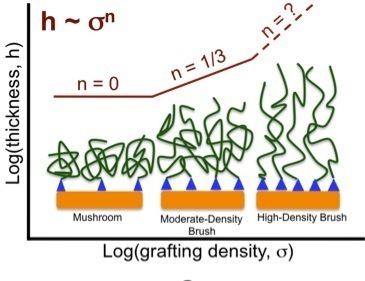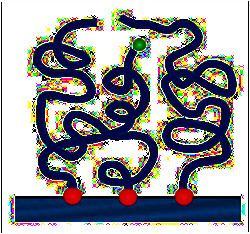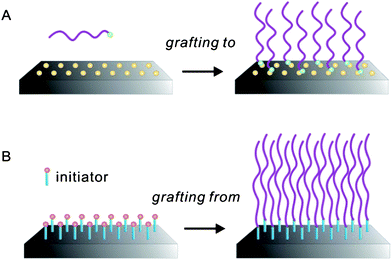 | ||
Self assembly of polymer brush functionalized inorganic nanoparticles
A Polymer brush is the name given to a surface coating consisting of polymers tethered to a surface. The brush may be either in a solvated state, where the tethered polymer layer consists of polymer and solvent, or in a melt state, where the tethered chains completely fill up the space available. These polymer layers can be tethered to flat substrates such as silicon wafers, or highly curved substrates such as nanoparticles. Also, polymers can be tethered in high density to another single polymer chain, although this arrangement is normally named a Bottle brush. Additionally, there is a separate class of polyelectrolyte brushes, when the polymer chains themselves carry an electrostatic charge.
Contents
- Self assembly of polymer brush functionalized inorganic nanoparticles
- Phase behavior of thin film polymer brush coated homopolymer systems
- Structure of a polymer brush
- From a dry brush to any brush
- References
The brushes are often characterized by the high density of grafted chains. The limited space then leads to a strong extension of the chains, and unusual properties of the system. Brushes can be used to stabilize colloids, reduce friction between surfaces, and to provide lubrication in artificial joints.

Polymer brushes have been modeled with Monte Carlo methods, Brownian dynamics simulations, and molecular theories.
Phase behavior of thin film polymer brush coated homopolymer systems
Structure of a polymer brush

Polymer molecules within a brush are stretched away from the attachment surface as a result of the fact that they repel each other (steric repulsion or osmotic pressure). More precisely, they are more elongated near the attachment point and unstretched at the free end, as depicted on the drawing.

More preciseley, within the approximation derived by Milner, Witten, Cates, the average density of all monomers in a given chain is always the same up to a prefactor:


where
The averaged density profile
A dry brush has a uniform monomer density up to some altitude
where
The above monomer density profile
regardless of the end monomer density profile
From a dry brush to any brush
As a consequence, the structure of any brush can be derived from the brush density profile
Correspondingly, the brush elastic free energy is given by:
This method has been used to derive wetting properties of polymer melts on polymer brushes of the same species and to understand fine interpenetration asymmetries between copolymer lamellae that may yield very unusual non-centrosymmetric lamellar structures.
